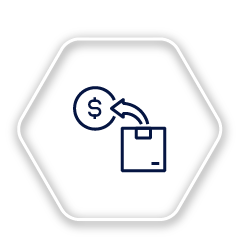Balancing service delivery against the need to economise to break even is a dilemma many retailers struggle with every day. In simple words, you have to figure out how to cut back and remain competitive strategically, all while ensuring you have sufficient staffing and resources. However, reducing unnecessary retail expenses is not just about minimizing your budget.
Increasing efficiency and embracing innovative solutions to cost-heavy challenges can make as much – if not more – impact than going for streamlining measures.
Note, though, that you've first to detect what is unnecessary. This bit is often the hardest. You may have to go back to your records to find out what you have consistently spent on.
Then, try to project how well your business can do without the items you've flagged off as unnecessary. To make the whole process smoother, it’s worth considering the following five tips for detecting unnecessary retail business expenses.
1. Office supplies and equipment
Technology plays a vital role at this point. Move whatever you can to the cloud. That way, you can quickly reduce the need for storage space, office equipment, and paperwork.
It does not end there, though. Numerous office functions call for the use of paper and similar supplies. In that case, buy in bulk.
Many offline and online paper product distributors can offer you discounts if you purchase in bulk. With that in mind, buy enough toner cartridges, pens, notepads, and lead pencils that can last for a whole year.
If, for one reason or another, you can't buy in bulk, join hands with other businesses, then purchase your supplies in one transaction. The amount of money you used to spend on operational costs can quickly turn into what you use for your office supplies alone.
2. Project management and job allocation
Sometimes, you’ll find yourself short-staffed, or face spikes in business that your existing employees will have a hard time keeping up with.
In such times, you don't have to overwork your staff and then offer to pay them for overtime. Consider doing a thorough audit of your staff roles to figure out what's a priority, and what can be postponed, delegated, or cancelled. If the increase in business is of a short-term seasonal nature, you’ll lose money on any new employees who won’t have anything to do once the season is over.
Find out who of your existing employees does what and how long they do it. An excellent way to go about this is by involving your staff. Get to know the challenges they face and listen to the solutions they suggest.
Also, before you hire someone in-house for a job that’s low in volume, consider outsourcing some business aspects to freelancers or specialised services like design, marketing and so on.
This strategy often comes with tons of perks. For instance, you may not have to worry about training costs once you choose to outsource. Simply look for competent staffing agencies in your niche.
3. Administrative and banking fees
Conduct a thorough audit each time you feel you're spending more than you should. It won't take you long before you realise much of what you spend goes to administrative fees.
To reduce administrative expenses, consider measures such as renting a property as opposed to buying. While you’re at it, think about whether the current space is too big for your retail business. Consider this: you likely pay per square metre for the shop space that you rent. This comes with a number of extra costs, such as higher utility bills.
Inspect all recurring costs and see where you can negotiate a better deal. Be it your internet and phone provider or the cleaning service, you might want to shop around to see where you can get a better deal for your money.
To reduce banking fees, consider switching to online banking. It'll save you time. If you already bank online, then review how you carry out your transactions.
You don't have to stick to automated services like Quick Lodge or ATM. Use other automated transactions like standing orders, direct credits, and direct debits. Then, by all means, encourage your customers to use such transactions.
Also, assess all software you use in your business. If you barely use a piece of software, paying for monthly subscriptions means losses on your side. Look for solutions that can consolidate more tasks in one, which will save you both time and money.
4. Shipping fees
Reducing shipping expenses can save your business some serious money. You can check with your carrier if they provide more affordable packaging solutions than the packaging that you source yourself. Some carriers offer free packaging for specific sizes or mail classes.
Don’t hesitate to inquire about bulk deals or discounts. Another way to reduce returns and losses is to go for shipping insurance. This method works because shipping insurance brings in the third party package insurer aspect.
You'll notice that in many cases, third-party package insurers are often cheaper than your preferred shipping carrier. In some cases, they charge half the price.
5. Asset management
There is a direct link between asset tracking and the ability to detect unnecessary retail business expenses. You can't tell what is unnecessary when you don't know what you have and where it is.
If you run a retail business, you've got a lot to lose if you don't get asset tracking right. You stand to lose more, not in terms of quality but rather, in terms of value.
Track any asset that has a high value. This includes moveable assets and assets that require regular maintenance. Bluntly put, track not just your vans in the field but also your office printers and other appliances.
Having the data on every asset that your business owns will help you make informed decisions. For example, you can consider insuring your assets if your business is susceptible to asset theft.
Also, you can see what pieces of equipment get used more often and where it would make sense to buy another piece of that equipment. Consider assets that are not performing well or require expensive maintenance, so you can replace them with more cost-effective solutions.
You can also know when it's time to replace worn-out or faulty assets if your assets are prone to wear and tear or tech redundancy. Keeping track of usage will help you keep tabs on the lifecycle so you can act before a crucial piece breaks down, bringing your business to a halt.
Conclusion
Detecting unnecessary expenses in your retail business can go a long way to help you break even. Start by looking at your current expenses and determine what costs you feel are too high or unnecessary so you can negotiate for more budget-friendly solutions.
Many small amounts quickly amass to a considerable amount of money you could otherwise invest in growing your business. Be proactive, gather your data, and start cutting unnecessary expenses today.


